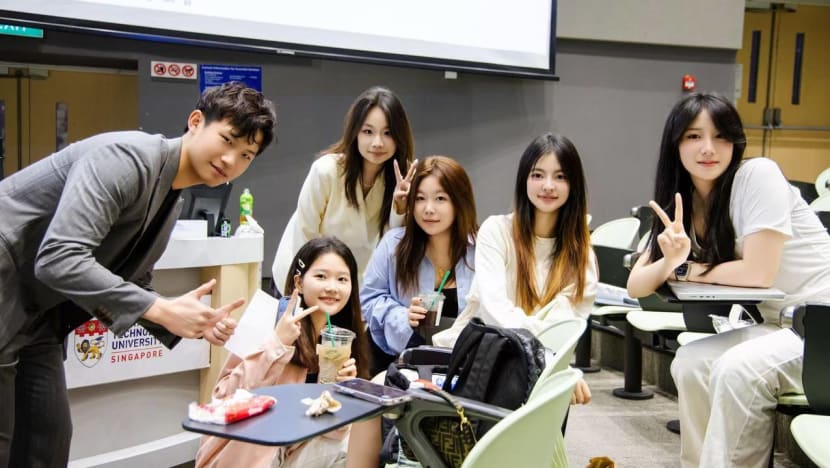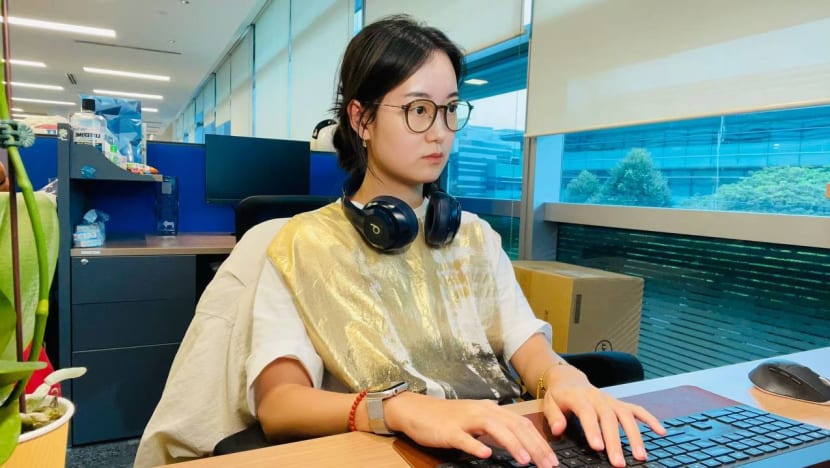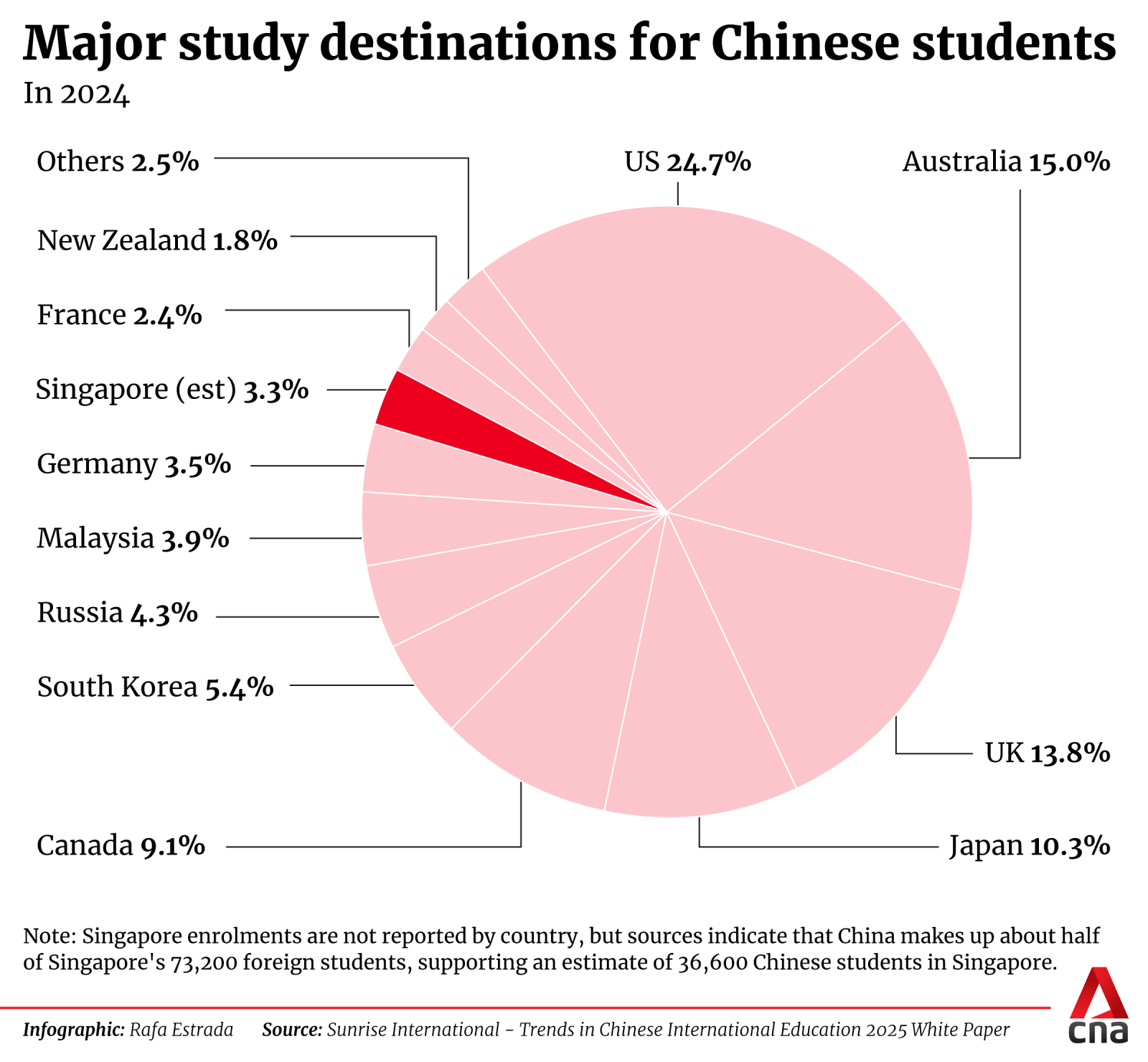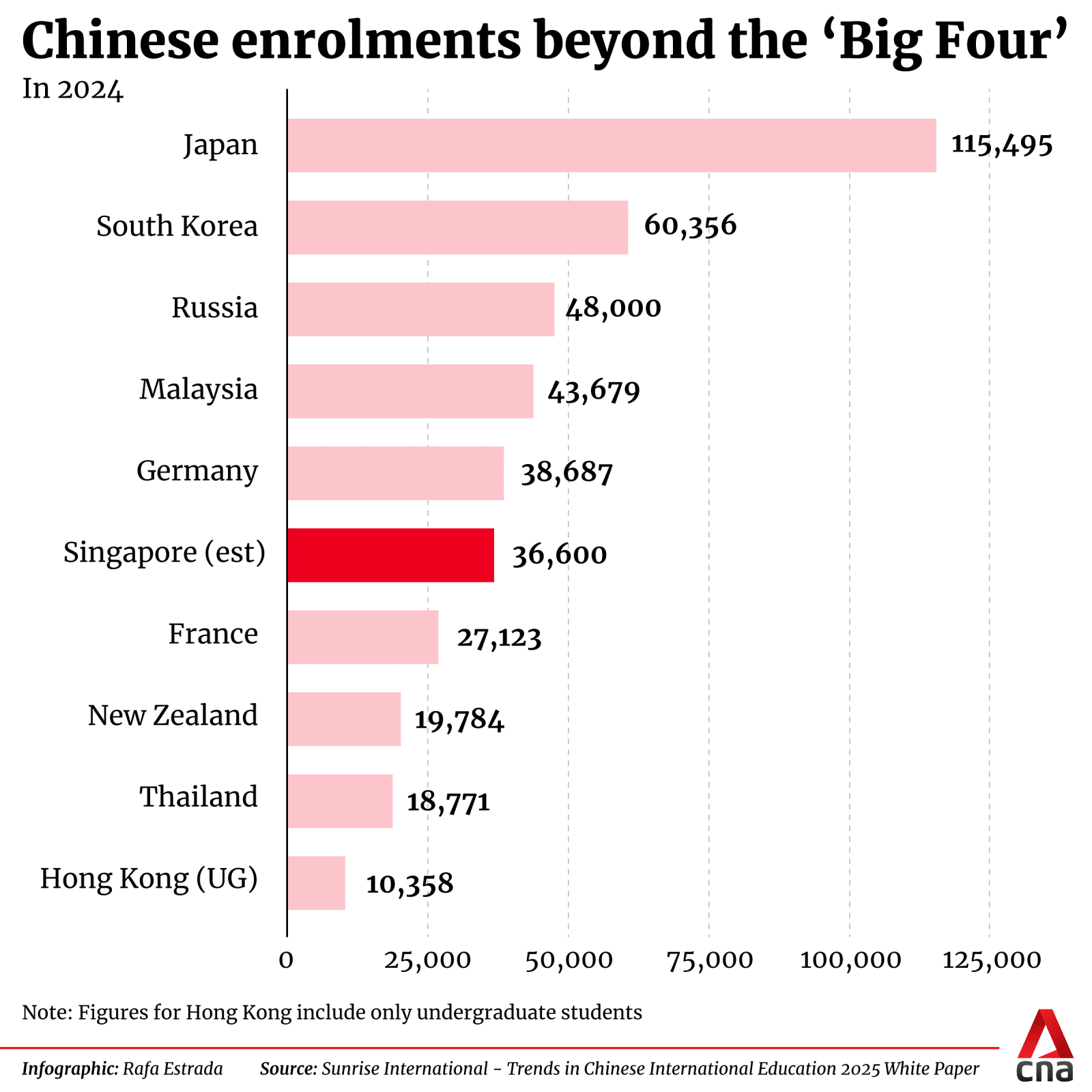China Power: Washington's loss, Beijing's gain as Chinese students shun the US for Southeast Asia?
As part of a series on China’s regional influence, CNA explores how the growing number of Chinese students in Southeast Asia is softening Beijing’s image and strengthening cross-cultural ties.
20-year-old Qin Sansan (right) from Guangzhou, now in her final year at Singapore's Nanyang Technological University, is part of a growing number of Chinese students pivoting away from Western universities. (Photo: Qin Sansan)
SINGAPORE: As global superpowers lock horns in a deepening US-China trade rivalry, the battleground has expanded far beyond trade routes and tech giants - reaching into university campuses.
Visa crackdowns, rising anti-China rhetoric, and the looming threat of sudden policy shifts have prompted many Chinese families to rethink higher education plans. Previously drawn to top-tier institutions in the US and UK, a growing number of students are now seeking alternatives that feel safer, more stable - and closer to home.
Southeast Asia, once seen as a backup, is quietly emerging as a new academic haven.
Wuhan native Qian Yaru is among the students who have made that pivot.
After earning her master’s in financial mathematics from the London School of Economics and Political Science and receiving offers from top-tier institutions in the US and UK, the 30-year-old ultimately chose Singapore to pursue her PhD in finance.
“Singapore is a very safe city - especially for females,” said Qian, now on full scholarship at Singapore Management University (SMU). “The main reason I came here was because of the political uncertainty elsewhere,” she added.
“With Trump’s new policies, you never know what’s going to come one or two years down the line.”

The growing presence of Chinese students on regional campuses is subtly softening China’s image - turning abstract geopolitics into real friendships.
Meanwhile, more Southeast Asian students are heading to China, drawn by its global stature and academic offerings, helping to bridge cultural gaps and recalibrate long-held views on both sides.
FINDING A SAFE HAVEN IN SOUTHEAST ASIA
Over the past decade, China has sent more students abroad than any other country. According to UNESCO data released in 2023, Chinese students studying overseas reached a record high of 1,021,303.However, in the US - long a key destination - those numbers have seen a sharp decline. Chinese nationals studying in the US dropped by 100,000 over the past four years, representing a 25 per cent decrease.
In recent weeks, US President Donald Trump revoked hundreds of international student visas, prompting concern from universities about the lack of clarity.
On Apr 9, China’s Ministry of Education issued a formal advisory, urging students to thoroughly assess risks when considering studying in the US. The alert was issued after a new bill in Ohio imposed restrictions on educational exchanges and academic partnerships between Chinese and American institutions.
"Geopolitical tensions inevitably affect the international flow of students," said Chen Zhiwen, from the Chinese Society of Educational Development Strategy.
“The US has been tightening its grip on China across multiple fronts - from trade to technology and now talent - creating a more hostile study environment,” he added.

Dr Ngeow Chow Bing, an associate professor and director of Universiti Malaya’s Institute of China Studies, said Western universities have been increasingly viewed “as being not as welcoming towards Chinese students as before”.
Many Chinese students have in turn been looking at universities in Southeast Asia for “relative safety and proximity”, Dr Ngeow said.
“Many families are quite worried about sending their children to the West (and) have been looking for other options and naturally, Southeast Asia is one.”
20-year-old Qin Sansan also had safety on her mind when making the decision to study in Singapore.
Coming from Guangzhou, Qin is now in her final year at Nanyang Technological University’s (NTU) Nanyang Business School.
Reports of frequent robberies and shootings in the US were key concerns, she said, adding that “even walking on the streets at night can be risky”.
“Places like the US and Canada are considered dangerous places. China is a country where guns are not common, so the presence of firearms makes it feel dangerous,” she said.
Their choices reflect a wider trend, which sees growing numbers of Chinese students pivoting away from Western universities, in favour of schools in Southeast Asia. It’s one that analysts say are reshaping the region’s educational landscape and subtly adding to China’s soft power strategy in the process.

SOFT POWER GROWS THROUGH STUDENT FLOWS
Southeast Asia has emerged as a standout, noted David Weeks, co-founder of Beijing-based international student consultancy Sunrise International.“The number of Chinese students in Southeast Asia is definitely increasing, and it's increasing faster than the number of outbound students that China sends overall,” Weeks told CNA.
Countries benefiting the most, he said, include Malaysia, Thailand, Singapore and the Philippines - where local universities are seeing consistent increases in Chinese enrolments.
Flagship institutes in Singapore, Japan and Hong Kong remain among the most attractive, consistently ranking high alongside the likes of Harvard and Cambridge in terms of global rankings.
According to Singapore’s Ministry of Education, the country hosted around 73,200 international students as of 2023, with Chinese students making up nearly half.
Japan saw an 11 per cent rise in Chinese student enrolments from 2022 to 2023. By 2024, they made up 41 per cent of the country’s international student population.
Top schools in the region, such as Thailand’s Chulalongkorn University and Universiti Malaya (UM) in Kuala Lumpur, have also been seeing an increase in Chinese student enrolments, observers said.
In Thailand, Chinese students now constitute a significant portion of international enrollees, overtaking those from neighbouring ASEAN countries. Chinese enrolments hit 18,771 in 2023, a 21.4 per cent increase from 2022, driven by affordable tuition fees and relaxed visa policies.
And in Malaysia, Chinese enrolments have surged fivefold in four years - from 8,876 in 2020 to nearly 44,000 in 2024, according to Education Malaysia Global Services.

Part of that wave is Michael Yang. After completing his master’s at UM in 2024, the Jiangsu native chose to remain in Malaysia to pursue a PhD in film studies and feminism.
“Malaysia is a melting pot of nationalities and cultures,” Yang told CNA, adding that he wanted to experience “a different educational environment”.
He interacts with a mix of local and international students on a daily basis and has built and fostered many “positive connections”.
Adjusting wasn’t always easy. Lacking local language skills and awareness of cultures and norms were big challenges at first, Yang said.
“I think the biggest adjustment for me was not eating pork. I can't eat pork because of the (predominantly Muslim) culture,” he said.
“And I was also not used to (hearing) daily prayer calls at 6am, but after a year, I got used to it because that is the country’s culture and I need to respect it.”


Meanwhile, in Thailand, Dong Ruofei found a different motivation: escaping China’s intense academic pressure and work culture.
“Competition in China is extremely fierce and it takes three years to graduate,” the 21-year-old student from Anhui told CNA, adding that she had not been confident of passing.
“Even if I did, the job market three years later might not be any better,” she said.
“The pressure in China can be overwhelming and I didn’t want to be just another statistic.”
Dong is currently pursuing her master’s degree in educational administration at Thailand’s Kanchanaburi Rajabhat University, located outside Bangkok.
On campus, she has picked up conversational Thai and enjoys spending time with her Thai teammates. She has even tried Thailand’s national martial art Muay Thai.
Cultural exchanges have been the highlight of her experience abroad, she said. Her university regularly organises events and activities for international students to truly experience Thai culture such as celebrations for the Songkran New Year as well as Thai Teachers’ Day.
Studying in Thailand has “reshaped her learning skills as well as perspectives of different cultures and approaches”.
“Southeast Asia is not a second-best option. Students studying here are by no means inferior to those in Europe or the US,” Dong said.
“In fact, in some companies, we are even more favoured by employers.”

CHEAPER FEES COME WITH CHALLENGES
Chinese students might have developed a reputation for being rich, but amid China’s slow economic recovery, cheaper tuition fees and more affordable lodging and living costs are becoming key considerations for many students and their families.
Annual fees at prestigious American universities and postgraduate programs range from US$27,300 to US$47,770, while UK degrees can cost between US$13,650 to US$40,945.
In contrast, tuition fees at lesser-known Southeast Asian universities can be as low as US$5,000 per year, proving more financially viable especially for many Chinese middle-class families in lower-tier cities, said Weeks.
“They are more likely to be price sensitive and feel that the most economically rational thing to do is sit out the (sluggish) job market for two years (while) living overseas,” he said.
“If they have to decide between studying abroad in a less prestigious destination or not studying abroad at all, some will choose the less prestigious one,” he added.
A 2024 survey by QS University Rankings found that 56 per cent of Chinese students looking to study in Southeast Asia cited affordability - including the offering of scholarships and a lower cost of living - as the most important factor.
Yang, currently in Malaysia pursuing his PhD on film studies and feminism, has been on a tight budget - covering his own rent and tuition fees.
“The cost of study and living in Malaysia is very cheap compared to Western countries,” he said.
But with the exception of universities in Singapore, degrees from lesser-known schools in some Southeast Asian countries are still unrecognised by Chinese employers, which could pose challenges for Chinese graduates in the long term, experts said.
Concerns over “shui bo” degrees, a slang term used online by Chinese netizens describing watered-down academic qualifications, have also sparked heated debate on Chinese social media.
“Chinese employers will have questions about degrees obtained from (lesser-known) Southeast Asian universities,” said Dr Ngeow, adding that students have complained about their degrees not being recognised or seen as credible by employers back in China.
Degrees from certain Southeast Asian universities and institutes may not carry the same weight as qualifications from the UK or US, said Weeks, who noted that a Malaysian degree is unlikely to “really turn heads” among Chinese employers unless the graduate is in the top percentile.
For Chinese students studying at these schools in the region, it can be a trade-off between low costs and the level of recognition among Chinese employers, Weeks added.
Expand
“HUMANISING” CHINA
The growing presence of Chinese students in colleges and universities across Southeast Asia has helped “humanise” China and soften its image in the region, said Dr Ngeow.“(They’re) not dealing with just an abstract notion of China - (they’re) dealing with people who have the same aspirations for their own careers,” he added.
All this comes at a crucial time for China as it strives to improve its image in Southeast Asia - its biggest trade partner and an increasingly important battleground for influence amid the intensifying US-China rivalry.
China remains the most influential superpower in the region - politically, strategically and economically - according to a recent survey by the ISEAS-Yusof Ishak think tank, which polled over 2,000 respondents from across 11 Southeast Asian countries.
But the report’s results also indicated that more countries favoured the US over China as the region’s preferred superpower.
Countries remain “divided in their trust toward China”, ISEAS said, with distrust levels especially high among respondents from Myanmar, Indonesia, Vietnam and the Philippines, who believed that “China’s economic and military power continues to threaten national interests and sovereignty”.
“A significant proportion of respondents from this group also think that China is not a reliable power, followed by those who feel that China is distracted by its internal affairs and thus cannot focus on global concerns,” ISEAS said.
“These evolving perceptions reflect a mix of optimism about China’s economic prospects and pessimism surrounding geopolitical tensions, which are important factors that will continue to shape ASEAN’s long-term perceptions of the country.”
When it comes to educational collaboration and outreach, experts say China and Southeast Asia enjoy a symbiotic and mutually beneficial relationship.
Chinese universities have long been expanding their presence in the region through vocational skills and bilateral exchange programmes under the Belt and Road Initiative (BRI) as well as the establishment of overseas Chinese campuses in countries such as Malaysia, Laos and Thailand.
“China wants to enhance more cultural and people-to-people ties for various engagements, and they have the resources to do it,” said Dr Ngeow, but added that the country still “lacked a coherent soft power strategy” in the higher education sector.
Daily interactions between Chinese students in Southeast Asia and their peers are “individual efforts” on the ground, which have played a wider and more influential role in Beijing’s soft power strategy, he added.
But Ngeow also noted the limitations to this form of soft power.
“I still will be careful to say that this does not necessarily translate into any immediate geopolitical impact,” he said
“Whether geopolitical alignments can be impacted by this kind of educational exchange, I think, is very, very unlikely on its own,” he added, citing the example of how distrust over the South China Sea dispute between China and the Philippines is unlikely to be resolved simply through student exchanges.


STUDENTS FIND CONNECTION ACROSS CULTURES
More Southeast Asians are also choosing to study, live and work in China.The 2025 ISEAS survey found that 5.5 per cent of Southeast Asian respondents said they would choose to live or work in China, a figure up from just 4.8 per cent in 2024.
Among them is Melissa Goh Zhi Yu, a 20-year-old Singaporean, currently studying at Peking University’s School of Journalism and Communications in Beijing. “Personally, it was about stepping out of my comfort zone,” she said, adding that China “had a lot to offer”.
Growing up, Goh was also part of many Chinese cultural school activities and language elective programmes. “I really love Chinese and want to improve my skills and return to Singapore effectively bilingual,” she said.
“As an international student in China, I’ve met many people from different parts of the world and it is really interesting to converse with them because most are effectively trilingual, which really amazes me.”
“Most of them are actually quite friendly and they are curious about your culture, your country and they are also willing to share about theirs as well,” said Goh.

Another Singaporean, Sheena Low, a 24-year-old student at Zhejiang University in Hangzhou, also said her real world experience of living and studying in China has been vastly different from negative opinions and perceptions expressed on many online platforms and sites - offering her a broader, more accurate view of the country.
“I do like China. I like Chinese culture like C-dramas and Chinese idols,” Low said.
“The people I’ve met here, from street cleaners on the street to aunties and uncles, have all been very friendly and are there to help if you need it.”
She has tried to adapt as much as possible but still gets homesick.
“I miss Singaporean food. I miss my mum.”
“My grandma passed away while I was in China so I could not go back to see her,” she added.
“But the people around me helped bring me out of my zone, (so I was not) left with my thoughts all day - it really helped.”
Dong sees “a mutually beneficial flow of knowledge” between students from China and Southeast Asia.
“For China, Southeast Asian students bring diverse perspectives and help fill talent gaps in fields like Southeast Asian studies and lesser-taught languages,” she said.
“For Southeast Asian students, China’s strengths in technology, engineering and career opportunities offered under the Belt and Road initiative are highly attractive … and if this trend is supported with measures like bilingual mentors, it could accelerate the formation of a regional talent network,” Dong added.
Yang from UM foresees more students from Southeast Asia going to China.
“By traveling to China for further studies, Southeast Asian students will have a more positive impact on the development of their home countries.”
“We have students from Singapore going to China. We also have students from China going to Singapore,” said Low, the Singaporean student at Zhejiang University, adding that support for international students has been strong.
“When you go to China to study, you get to see China in a different way and how it treats international students very well,” Low said.
“It’s this cultural exchange that will help strengthen ties between countries and I think that is the most important part.”
Qian, the SMU student, said she does not regret her decision to study in Singapore.
“I expected a cultural shock when I arrived because I was still a foreigner, but there was none,” she said.
Singaporeans and Chinese students share a “similar Asian mindset”, she added.
“Many people here speak Chinese, even (if it’s) with local accents, which reminds me of my hometown, so I felt an immediate connection,” she said, recalling her experiences so far.
“I’ve found that people here are genuinely kind and I can truly trust strangers on the street,” she said.
“Once, I lost my power bank in a food court and several strangers came over to help me search for it - something you wouldn’t see in China, where people are less trusting and more focused on their own lives.”
It’s precisely these day-to-day experiences - subtle and personal - that are bridging the gaps.
“What actually shapes views? It’s classmates, roommates, professors, (because) it is hard to demonise people that you are friends with,” said Weeks from Sunrise International.
“That, in itself, is soft power.”
Source: https://www.channelnewsasia.com/eas...utheast-asia-boost-beijing-soft-power-5066591
